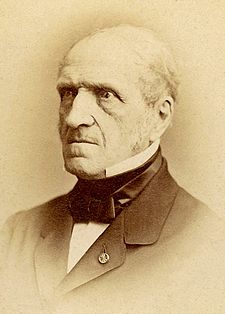- Michel Chasles
-
Michel Chasles 
Michel ChaslesBorn 15 November 1793
Épernon, FranceDied 18 December 1880
ParisDoctoral advisor Siméon Denis Poisson Doctoral students Jean Gaston Darboux
Hubert Anson NewtonNotable awards Copley Medal Michel Floréal Chasles (15 November 1793 – 18 December 1880) was a French mathematician.
He was born at Épernon in France and studied at the École Polytechnique in Paris under Siméon Denis Poisson. In the War of the Sixth Coalition he was drafted to fight in the defence of Paris in 1814. After the war, he gave up on a career as an engineer or stockbroker in order to pursue his mathematical studies.
In 1837 he published his Historical view of the origin and development of methods in geometry, a study of the method of reciprocal polars in projective geometry. The work gained him considerable fame and respect and he was appointed Professor at the École Polytechnique in 1841, then he was awarded a chair at the Sorbonne in 1846. A second edition of his book was published in 1875, and Leonhard Sohncke translated the work into German.
Jakob Steiner had proposed the problem of enumerating the number of conic sections tangent to each of five given conics, and had answered it incorrectly. Chasles developed a theory of characteristics that enabled the correct enumeration of the conics (there are 3264) (see enumerative geometry). He established several important theorems (all called Chasles' theorem). That on solid body kinematics was seminal for understanding their motions, and hence to the development of the theories of dynamics of rigid bodies.
In 1865 he was awarded the Copley Medal.
As described in A Treasury of Deception, by Michael Farquhar (Peguin Books, 2005), between 1861 and 1869 Chasles purchased over 27,000 forged letters from Frenchman Denis Vrain-Lucas. Included in this trove were letters from Alexander the Great to Aristotle, from Cleopatra to Julius Caesar, and from Mary Magdalene to a revived Lazarus, all in a fake maedieval French. In 2004, the journal Critical Inquiry published a recently uncovered 1871 letter (translated by Northwestern University historian of science Ken Alder) written by Vrain-Lucas (from prison) to Chasles, conveying Vrain-Lucas's perspectives on these events.
In 1986, Alexander Jones published a commentary on Book 7 of the Collection of Pappus of Alexandria, which Chasles had referred to in his history of geometric methods. Jones makes these comments about Chasles, Pappus and Euclid:
- Chasles's contribution to our comprehension of the Porisms tends to be obscured by the inherent unreasonableness of his claim to have restored substantially the contents of Euclid's book on the basis of the meagre data of Pappus and Proclus...one still turns to Chasles for the first appreciation of the interest in the Porisms from the point of view of modern geometry. Above all, he was the first to notice the recurrence of cross-ratios and harmonic ratios in the lemmas, and because these concepts suffuse most of his restoration, it is probable that many of his inventions coincide with some of Euclid's, even if we cannot now tell which they are.
Chasles' name is one of 72 that appears on the Eiffel Tower.
References
- O'Connor, John J.; Robertson, Edmund F., "Michel Chasles", MacTutor History of Mathematics archive, University of St Andrews, http://www-history.mcs.st-andrews.ac.uk/Biographies/Chasles.html.
- Michel Chasles at the Mathematics Genealogy Project.
- 1910 New Catholic Dictionary
- Ken Alder, "History's Greatest Forger: Science, Fiction, and Fraud Along the Seine," Critical Inquiry 30 (Summer 2004):704-716.
- Alexander Jones (1986) Book 7 of the Collection, part 1: introduction, text, translation ISBN 0387962573 , part 2: commentary, index, figures ISBN 3540962573 , Springer-Verlag .
Categories:- 19th-century mathematicians
- French mathematicians
- Geometers
- University of Paris faculty
- Recipients of the Copley Medal
- Alumni of the École Polytechnique
- Members of the French Academy of Sciences
- Lycée Louis-le-Grand alumni
- 1793 births
- 1880 deaths
- Foreign Members of the Royal Society
Wikimedia Foundation. 2010.
